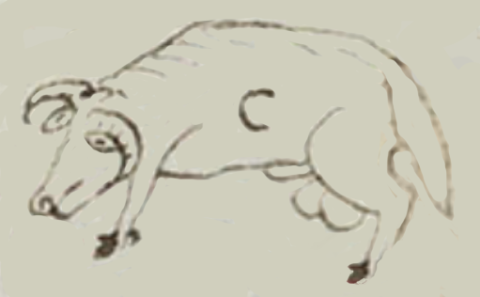carnero (CST33)
This painting of the simplex glyph for the Spanish loanword carnero (ram) shows a profile of a ram facing toward the viewer’s left. It has horns that curve downward and large testicles. On the next page, an identical animal is employed to refer to a stock-raising enterprise for ichcatl.
Stephanie Wood
Europeans introduced sheep (and stock raising, in general) to the Americas. The companion text explains that one hundred rams were purchased for the purpose of breeding. The next page refers to a stock-raising ranch (estancia). The cost was 6 tomines per ram. A Juan López of Teposcolula (spelled here Tepuzcululan) made the sale. On the next page, perhaps a brother is mentioned, Gabriel López, along with what I would interpret to be the founding of the estancia. For more on the Codex Sierra, see Kevin Terraciano’s study (2021), especially p. 120 (for the Nahuatl transcription) and 155 (for the English translation). For other glyphs or examples of iconography relating to animal husbandry, see below.
Stephanie Wood
carneros
Stephanie Wood
1550–1564
Jeff Haskett-Wood
carneros, cuernos, crianza, ganadería, estancias, lana

carnero, a ram (a loanword from Spanish taken into Nahuatl), https://nahuatl.wired-humanities.org/content/carnero
carnero
Stephanie Wood
Códice Sierra-Texupan, plate 33, page dated 1560. Origin: Santa Catalina Texupan, Mixteca Alta, State of Oaxaca. Kevin Terraciano has published an outstanding study of this manuscript (Codex Sierra, 2021), and in his book he refers to alphabetic and “pictorial” writing, not hieroglyphic writing. We are still counting some of the imagery from this source as hieroglyphic writing, but we are also including examples of “iconography” where the images verge on European style illustrations or scenes showing activities. We have this iconography category so that such images can be fruitfully compared with hieroglyphs. Hieroglyphic writing was evolving as a result of the influence of European illustrations, and even alphabetic writing impacted it.
https://bidilaf.buap.mx/objeto.xql?id=48281&busqueda=Texupan&action=search
The Biblioteca Digital Lafragua of the Biblioteca Histórica José María Lafragua in Puebla, Mexico, publishes this Códice Sierra-Texupan, 1550–1564 (62pp., 30.7 x 21.8 cm.), referring to it as being in the “Public Domain.” This image is published here under a Creative Commons license, asking that you cite the Biblioteca Digital Lafragua and this Visual Lexicon of Aztec Hieroglyphs.






